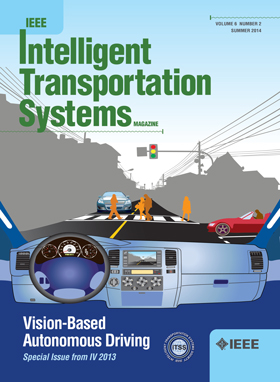铁路计算机视觉研究进展
IF 8.4
1区 工程技术
Q1 ENGINEERING, CIVIL
IEEE Transactions on Intelligent Transportation Systems
Pub Date : 2025-06-04
DOI:10.1109/TITS.2025.3552011
引用次数: 0
摘要
现代铁路继续努力采用远程和自动化的方法来改进对其资产的目视检查程序。在某些情况下,这些检查提供了以前无法收集的新信息,而在其他情况下,它们帮助他们改进与人工检查有关的质量控制、安全、时间和成本。因此,计算机视觉继续在视觉检查轨道,土方工程,隧道,架空线路设备和机车车辆方面找到应用。考虑到计算机视觉相关发展的最新步伐,本文试图回顾铁路领域的艺术状态。首先,讨论了硬件和数据要求,重点讨论了在铁路环境中操作光学设备所面临的独特挑战,如污染、电源和照明。本文还讨论了照相机硬件最常见的安装方式,包括机车车辆、卫星和路旁照相机。接下来,讨论了图像处理算法,比较了经典方法和更现代的人工智能方法,例如You Only Look Once (YOLO)和基于区域的卷积神经网络(R-CNN)。然后分析了计算机视觉在铁路工业中最常见的应用。首先对轨道进行了计算机视觉分析,以检测平线和道岔上不同类型的轨道表面缺陷、扣件缺陷、混凝土轨道板开裂和道砟颗粒特征。接下来,考虑架空线路设备与检测受电弓和接触线之间的接触损耗,交错行为和有缺陷的接触网组件相关的应用。接下来是讨论其他应用,如铁路隧道沉降、隧道检查、平交道口、非法侵入和轨道安全隐患。最后,讨论了未来研究的机会,如高光谱成像和生成人工智能,以及可能的前沿技术,如量子计算。本文章由计算机程序翻译,如有差异,请以英文原文为准。
A Review of Computer Vision for Railways
Modern railways continue to strive for remote and automated methods to improve the visual inspection procedures for their assets. In some cases, these inspections provide new information that could not previously be collected, while in other cases they help them improve upon the quality control, safety, time and costs associated with manual inspection. As such, computer vision continues to find applications for visually inspecting the track, earthworks, tunnels, overhead line equipment and rolling stock. Considering the recent pace of computer vision related developments, this paper seeks to review the state of the art of the field for railways. First, the hardware and data requirements are discussed, focusing on the unique challenges associated with operating optical equipment in a railway environment, such as contamination, power sources and lighting. This also discusses the most common mounting arrangements for camera hardware, including rolling-stock, satellites and way-side cameras. Next, image processing algorithms are discussed, comparing classical approaches and more modern artificial intelligence approaches, for example You Only Look Once (YOLO) and Region-Based Convolutional Neural Network (R-CNN). Then the most common applications for computer vision in the rail industry are analysed. First the track is studied considering computer vision analysis for the detection of different types of rail surface defects on plain line and turnouts, fastener defects, concrete track slab cracking and ballast particle characterisation. Next, the overhead line equipment is considered with applications related to detecting contact loss between pantograph and contact wire, stagger behaviour and defective catenary components. This is followed by discussion of other applications such as rail tunnelling subsidence, tunnel inspection, level crossings, trespass and on-track safety hazards. Finally, opportunities for future research are discussed such as hyperspectral imaging and generative AI, along with possible frontier technologies such as quantum computing.
求助全文
通过发布文献求助,成功后即可免费获取论文全文。
去求助
来源期刊

IEEE Transactions on Intelligent Transportation Systems
工程技术-工程:电子与电气
CiteScore
14.80
自引率
12.90%
发文量
1872
审稿时长
7.5 months
期刊介绍:
The theoretical, experimental and operational aspects of electrical and electronics engineering and information technologies as applied to Intelligent Transportation Systems (ITS). Intelligent Transportation Systems are defined as those systems utilizing synergistic technologies and systems engineering concepts to develop and improve transportation systems of all kinds. The scope of this interdisciplinary activity includes the promotion, consolidation and coordination of ITS technical activities among IEEE entities, and providing a focus for cooperative activities, both internally and externally.
 求助内容:
求助内容: 应助结果提醒方式:
应助结果提醒方式:


